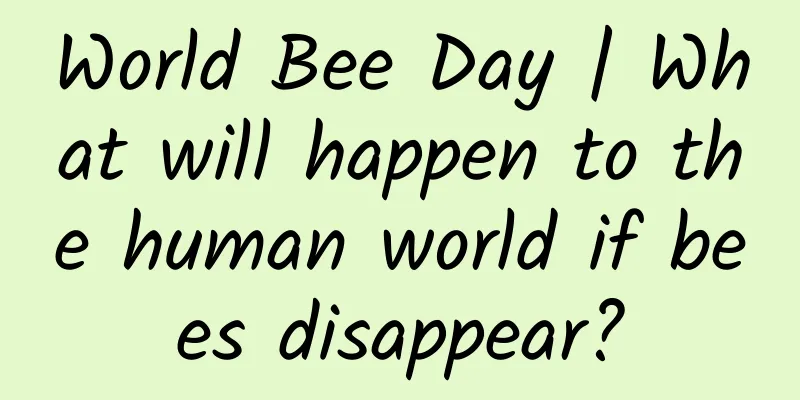World Bee Day | What will happen to the human world if bees disappear?

|
Have you ever been stung by a bee? Recently, with the increasing enthusiasm of people going out for fun, news about tourists being stung by bees has frequently become a hot topic. So, I wonder if you have ever thought about this question: how much influence do bees have on our lives? What would happen to the world if bees disappeared? As World Bee Day is approaching, let us take a closer look at the great achievements of bees. First of all, when it comes to bees, you may instinctively think of the image of bees that live in a big beehive, are yellow in color, and have stripes on their bellies, but in fact, the bee family is much larger than you think. Fossil evidence shows that the earliest bees appeared in the early Cretaceous period, earlier than the dinosaurs. So far, there are more than 12,000 members in the living Hymenoptera and Apoidea. However, among so many bees, there are actually not many that can make honey. But do you think the meaning of their existence is to help you make nectar? No, in fact, in nature, the contribution of bees is much greater than you think, that is, they can help plants spread pollen. The act of pollination seems simple, just carrying pollen from one flower to another, but it is extremely important to the evolution of plants and the development of human beings. First of all, pollination can promote the exchange of plant genes, allowing them to better adapt to the environment. Studies have shown that it is with the help of pollinating insects that the evolution of plants has entered the fast lane. Secondly, for us humans, pollination is also conducive to the emergence of high-quality crops and the increase of crop yields and incomes. At present, there are more than 1,300 species of plants in the world that can be used by us, including food crops, medicinal plants, industrial plants, ornamental plants, and so on. Image from Tuchong.com Among these plants, more than 1,100 species require bees for pollination. Compared with other pollination methods such as wind pollination, bee pollination is more accurate and effective. The yield of plants pollinated by bees is also higher than that of plants pollinated by other methods. For example, the yield of cotton can even be increased by 38% after bee pollination. According to statistics, pollinating insects have increased the world's crop yields by nearly 75%. Among the five major pollinating insects, bees, butterflies, beetles, flies, and moths, bees contribute the most. However, the bad news is that the number of bees in the world is continuing to decline. For example, the number of bees in Europe and the United States has dropped by more than 30%. A large number of beehives have been abandoned by bees, and the larvae have been abandoned in the nests. Scientists have named this phenomenon "colony collapse syndrome." In addition to causing huge losses to the planting industry in some regions, colony collapse syndrome has also led to the extinction of some bees, such as North American bumblebees. There is currently no universally accepted explanation for the cause of this phenomenon, but biologists speculate that it should be related to the use of chemical pesticides, environmental pollution, malnutrition, viruses, parasitic diseases, and changes in planting patterns. In addition, due to the epidemic and economic factors, the number of beekeepers around the world is also declining, which has also directly led to a decrease in the number of bee colonies. However, in contrast, the demand for bees in agriculture and planting is increasing day by day. In the past 30 years, the global agricultural pollination demand has increased at an average rate of 1.78% per year, more than twice the annual growth rate of domesticated bee colonies. It can be said that bees have become an important factor restricting the plant industry. In order to solve this problem, researchers have also thought of many ways, such as strictly controlling the use of pesticides, improving the composition of pesticides, or developing pollination robots. However, due to factors such as cost and the physiological characteristics of the plants themselves, these methods have little effect at present, and we do not see any signs that they can replace small insects such as bees in the short term. So, if bees really disappear from our side, what impact will it have on our lives? There is a saying that "if bees disappear, humans will live for at most four more years." It is currently impossible to verify who said this, but it does reflect the importance of bees to a certain extent. However, whether humans can only live for another four years is a bit alarmist. As mentioned earlier, the world's main pollinating insects are bees, butterflies, beetles, flies, and moths. In addition, some mammals and birds have the ability to pollinate. Although the pollination efficiency of these animals is not as high as that of bees, they can also play a supplementary role to a certain extent. However, one thing is certain: if bees really disappear, the plant industry will inevitably suffer a heavy blow, and some crops will be reduced or even extinct, which will cause economic fluctuations. We may have a much harder time than we do now. Therefore, protecting small insects like bees is a major issue that concerns our lives. So, what can ordinary people do? There are many things we can do, such as reducing the use of pesticides, planting more flowering plants, protecting the environment in areas with beehives, sponsoring the beekeeping industry, etc. I hope that with our joint efforts, these small insects can continue to fly freely among the flowers! This article is a work supported by Science Popularization China Starry Sky Project Author: Shan Shaojie Reviewer: Yin Haisheng (Researcher-level senior engineer at Shanghai Insect Museum, Chinese Academy of Sciences) Produced by: China Association for Science and Technology Department of Science Popularization Producer: China Science and Technology Press Co., Ltd., Beijing Zhongke Xinghe Culture Media Co., Ltd. |
Recommend
How does BuzzFeed, the American version of Toutiao, achieve viral communication?
At the beginning of the year, Bytedance's XX ...
What are the reasons for being banned in Taobao live streaming rooms? Can you know it yourself?
This article mainly introduces the reasons for be...
A must-read for office workers! These 3 methods will help you have a high-quality nap in a short period of time!
Source: Dr. Curious The cover image and the image...
5 tips for brand marketing positioning!
There are many ways to position yourself, but the...
Information flow promotion, what are the advantages and effects of Douyin advertising?
Tik Tok is the most popular trendy short video so...
How to use coupons and cases
Coupons are a form of "expression" in m...
Why can pigeons return to their homes no matter where they fly?
Audit expert: Zhao Liangyu Associate Professor, S...
This water-powered observatory is actually the "ancestor" of the world clock!
Your browser does not support the video tag Day a...
ASO keyword selection skills!
As we all know, the first step for everyone after...
Zeng Meijuan Weibo: Common problems and solutions for SEO promotion
With the development of the Internet, SEO promoti...
“Hahaha”, this is the reason?!
Source: Minitory This article has been authorized...
3 major elements to create addictive products and brands!
Everyone's persistent pursuit and unremitting...
Talk about the difference and inspiration between traffic and users
Recently there was a discussion topic about traff...
The Three Rhythms of Brand Strategy Writing
In the previous article, we took a unique perspec...









